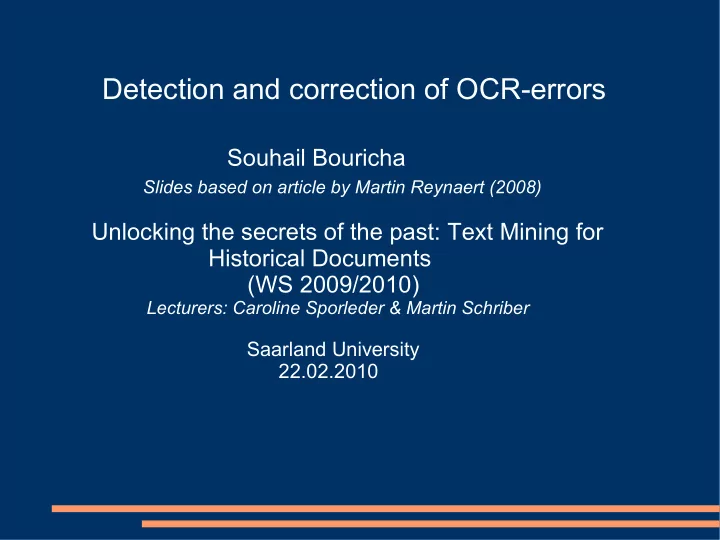

Detection and correction of OCR-errors Souhail Bouricha Slides based on article by Martin Reynaert (2008) Unlocking the secrets of the past: Text Mining for Historical Documents (WS 2009/2010) Lecturers: Caroline Sporleder & Martin Schriber Saarland University 22.02.2010
• What is OCR? ● Optical Character Recognition ● Branch of computer sciences that involves: - reading text from paper - translating the images into a manipulated form ● OCR systems use a combination of Hardware/Software to recognize characters ● OCR technologie is said to have been born in 1951 with M. Sheppered's invention GISMO
Reasons for using OCR ● To reduce data entry errors ● To consolidate data entry ● To handle peak loads ● Human Readable ● Can be used with any printing techniques ● Scanning correction ● Eco-friendly
How does OCR work? ● Pattern Matching: compares what the OCR scanner sees as character with a library of character matrices or templates ● Feature Extraction: - Known as Intelligent Character Recognition (ICR) - This method varies by how much ''Computer Intelligence'' is applied by the manufacturer - The computer looks for general features such as open areas, closed shapes, diagonal lines, etc.
OCR Fonts A font is the term given to a set of characters, for example in English language usually 0-9, A-Z and a few special characters. Each character within a font will have a defined reproducible size and shape.
OCR's efficient? OCR system reaches 99% word accuracy!!! One word will have been misrecognized out of every 100 words processed
Error Sources ● Text location and format ● Print quality ● Paper quality ● Positioning a Scanner ● Writing quality
Corpora of the Cultural Heritage 1- SGD: ''Staten Generaal Digitaal'' Contemporary collection comprise the published acts of Parliament (1989-95) of the Netherlands 2- DDD:''Database Digital Daily newspapers'' - Historical collection - published between 1918-46 - was written in an older Dutch spelling 3- TWC02: Contemporary one year newspaper corpus(2002), 5 Dutch newspapers, one called ''Het Volk''
Background Token : Number of words in a text(are repeated) Types : abstract and unique Ratio : Number representing a comparison between two things Born-Digital : (Natively digital vs. Digital reformatting) Materials that originate in a digital form Hapax legomena : A word occuring only once in a given corpus
Lexical Variation in Corpora
Categories of errors 1- Transposition 2- Insertion 3- Deletion 4- Substitution
OCR Post-correction ( TICCL ) - Text-Induced Corpus Clean-up - automatic - work for most alphabetical languages - does not try to account for unknown word types - the system can be run with or without an extra validated word lexicon - the system is able to drive a word type list from a backgound corpus
Anagram Hashing The numerical value for a word string is obtained by summing the ISO Latin-1 code of each character in the string raised to a power n, where n is emperically set at: 5. L E Transposition X I C Deletion O The focus word N Insertion H A Substitution S H
Processing Steps 1- we compare each word with the background lexicon 2- Each word in the corpus has a diffrent frequency 3- we associate the frequency of a word in the corpus with the same word in lexicon 4- TICCL reads a list of variants of the focus word (only if it's available) 5- TICCL returns: focus word and retrieved variant (That we got through Lexicon and Morphological filter)
Recommend
More recommend